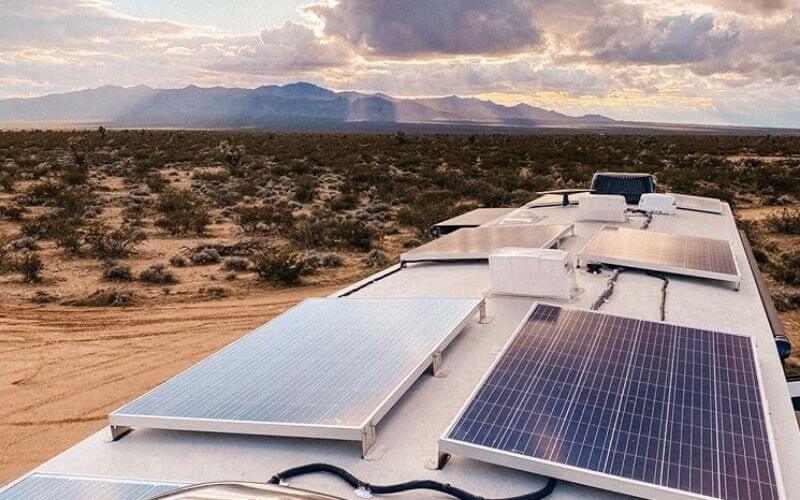Today the solar power revolution has emerged at the consumer level. It’s become increasingly popular with campers, and especially RV travelers.
Not only is it “Green” but modern solar panels are also efficient enough to reduce or sometimes eliminate an RV’s need for a traditional gasoline or diesel-powered generator.
This might leave you wondering, just how much solar power do I need to power my RV?
An average travel trailer need 120 Amp Hours of solar power, whereas a luxury fifth wheel or Class A motorhome might need 240 to 360 Amp Hours of solar power to truly maintain its arsenal of appliances and creature comforts. So, this wide range will influence just how long it takes for you to see a full return on your initial investment.
To truly find out just how much solar power your RV needs, we’re going to need to take a closer look at how solar power works, How much power do you need?
How many panels, and what size? how to store the energy it creates, and how to accurately determine your wattage needs.
How Does An RV Solar Panel Work?
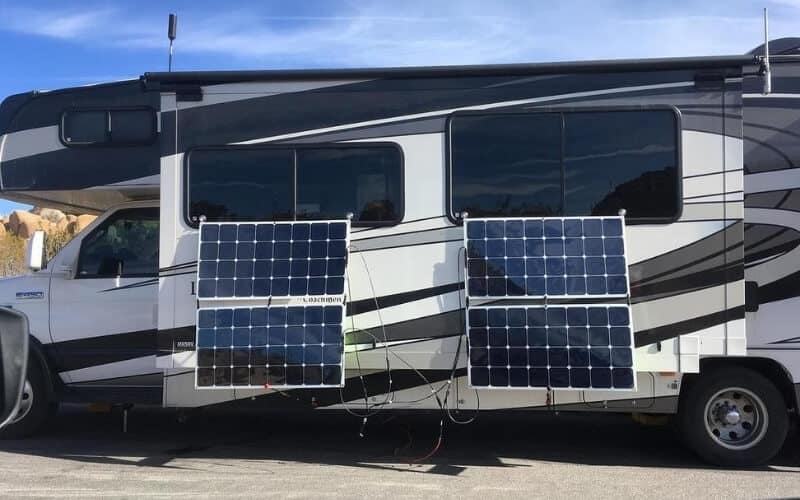
Solar panels are technically a collection of photovoltaic cells that are made from special light-absorbing polymers.
This produces DC (Direct Current) which can then be stored in the RV’s 12 Volt batteries.
The RV’s onboard inverter then turns it into the AC (Alternating Current) that many of your RV’s appliances run on.
Calculating How Much Solar Power Do you Need for your Camper
An important first step in determining the solar panels and square footage you need to power your RV, you’ll first need to determine your typical wattage needs on an average day in your RV.
The last thing you want is to run short on current for simple things like turning on the lights or running the microwave.
Yet for something that might seem simple, there are a few different ways to do the math on your wattage needs.
Calculating Your Wattage Needs By Appliance Use
The first option is to add up the total amount of watts all the various appliances in your RV are rated for.
This is a little bit tedious, in that you need to look up each appliance and write down its specs. Most have the necessary information stamped, printed, or etched on them.
Though there might be a few RV appliances that will call for digging around in the owner’s manual or looking them up online.
Total up the number of watts you are going to use per day, per appliance, based on the estimated hours you will be using them.
To get this method right you need to be meticulous. If you’re watching your flat-screen TV for an hour, make sure to add the watts per hour.
Be sure to include the other things the TV is using like the wattage draw of the receiver, the DVR, or the gaming console you’re using as a DVD player.
By the time you’re done with this method, you might end up feeling like you’ve wasted precious hours of your life.
Still, if you are exacting in your approach, you’ll end up with a relatively accurate assessment of your wattage needs.
You can then factor this into the capacity of the battery bank you will need as well as the size, type, and wattage requirement of the photovoltaic solar panels.
Calculating Your Wattage Needs In A Real World Test
Sometimes referred to as the “Camping Test” it tends to give you the best real-world result.
You just have to be prepared to have a few hiccups along the way on a boondocking, off the grid adventure.
Ideally, you want to pick a location that’s close enough to a reliable source of backup power.
That way if something goes wrong, you can just plugin, or take a short drive home.
If you happen to have a big enough backyard, you might want to just set up at home for the weekend and keep your RV completely disconnected from the house.
This is admittedly an easier thing for a couple to do, than it is for a family with small children, who are all too tempted to run into the house and play their favorite video games.
For this real-world test to work, you want to try to live like you normally would.
Don’t go out of your way to conserve power use, or over-use electricity, which will skew your results when it comes time to determine your battery and photovoltaic solar panel needs.
You’ll also need to get your hands on a battery meter, which is something you’ll likely need in the end anyway.
Once it’s connected to the system you can monitor the discharge levels of your batteries.
Ideally, you don’t want your lead-acid batteries to dip below 50% as it could damage or shorten the battery’s overall lifespan.
When you’re done, you can use the amount of power consumed to determine your wattage needs.
This involves calculating the amp hours of the battery. Let’s say for example you have a 240 amp hour battery bank and at the end of your little weekend experience, you find that you’ve used half of the total stored current.
This means you’ve consumed 120 amp hours, which is the equivalent of 60 amp-hours per day.
While you’re going through this test, be mindful of your battery level. If you start dipping below 50% you might need to make some changes in the end product.
If you end up completely draining the batteries on your boondocking experiment you should see it as a red flag, telling you that you will need to make some major upgrades to your battery bank as part of your solar panel installation.
How Do I Convert Watts To Amp Hours?
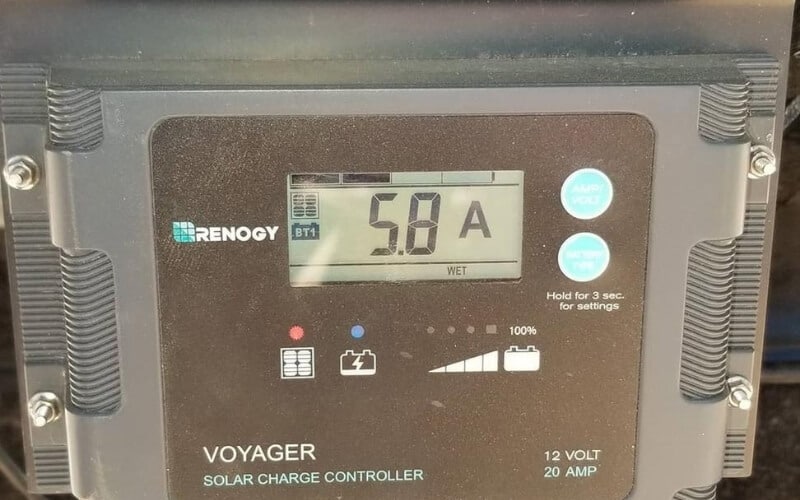
There isn’ttechnically a 1:1 Amp Hour to Watts equation. Instead,it’s a process where you first calculate your Watt-hours. Then you can translate that figure to Amp Hours.
- Amp-hours multiplied by Volts = Watt-hours
- This means that conversely Watt-hours divided by Volts = Amp-hours
Batteries have the voltage printed on them, which makes it easier for you to plug into the equation.
If you’ve taken a tally of your estimated wattage consumption in a given hour, you can plug that into the equation as well.
It’s exactly the sort of thing your 9th-grade algebra teacher taught on a random Tuesday afternoon and you might have replied “When am I going to use this in real life?”
So, let’s put it into a real-world example. Let’s say you have a 60-Watt lightbulb that you leave on for 3 hours.
This means it would consume a total of 180-Watt hours. Then, let’s also assume that you have it connected to a simple 12-Volt battery.
With this information in hand, we can plug it into the equation by dividing the Watt Hours of 180 by the 12 Volts of the battery which reveals a total of 15 Amp Hours of charge will be needed to properly supply the battery for 3 hours.
You can then divide the 15 Amp Hours by 3 to see that this single light bulb will take up 5 amps for every hour you use it.
Determining Your Available Space For Solar Panels
Regardless of the method you choose, you should have a pretty good ballpark or exact watts that you know you need.
Next comes a realistic understanding of how much space you have to work with both on and around your RV’s exterior.
You should note thatit’s possible that your wattage needs might be more than the available square footage you can reasonably use.
So, calculating your available space, and the panels you choose will help you pair your RV solar array to the type of battery you need to maintain capacity.
These days solar panel technology continues to evolve. Photovoltaic cells are starting to become more and more capable of generating more electrical charge per square inch than even a decade ago. So, be sure to read the fine print on any solar panel you are shopping for.
As a general rule of thumb though, a 100-Watt solar panel is capable of producing up to 30 Amp Hours of charge in a single day.
Just bear in mind that this is a ballpark estimate and it relies on nearly ideal full-sun conditions during a long summer day.
If you are going to be camping under thick tree cover, or the weather is filled with dark storm clouds, the photovoltaic cells could end up producing less than this.
Ultimately, unless you are going to be camping in the desert with a wide-open sky overhead at all hours of the day, chances are you are only going to see 70 to 90% of possible peak production.
Planning for 75% production capacity when designing your system will give you the best results.
Then when “Ideal” conditions do prevail, you’ll be pleased, rather than feeling let down by your solar investment.
How Many Solar Panels Do I Need For My RV?
Now let’s say that you’ve crunched your numbers to the point where you know that you need 50 Amp Hours per day to maintain the preferred comfort level of camping in your RV.
Let’s also say that we found a great deal on solar panels that are rated to produce up to 100 Watts of power in a given hour.
The average measurements of a panel like this, given today’s level of photovoltaic efficiency, rings in at around 48-inchesby 20-inches.
We can even go so far as to assume that our campsite and the prevailing weather will give us at least 6 glorious hours of full solar exposure. This equates to 32 Amp Hours for our 12 Volt battery system.
In this instance, with a single 48 X 20-inch solar panel would be a little bit under the mark.
If you were boondocking, you’d need to still run your generator from time to time.
Fortunately, for most travel trailers, there’s more than enough room on the roof to easily accommodate 2 solar panels this size, if not 3, without having to worry about one shading another.
How Much Battery Capacity Do I Need To Support My Solar Panels?
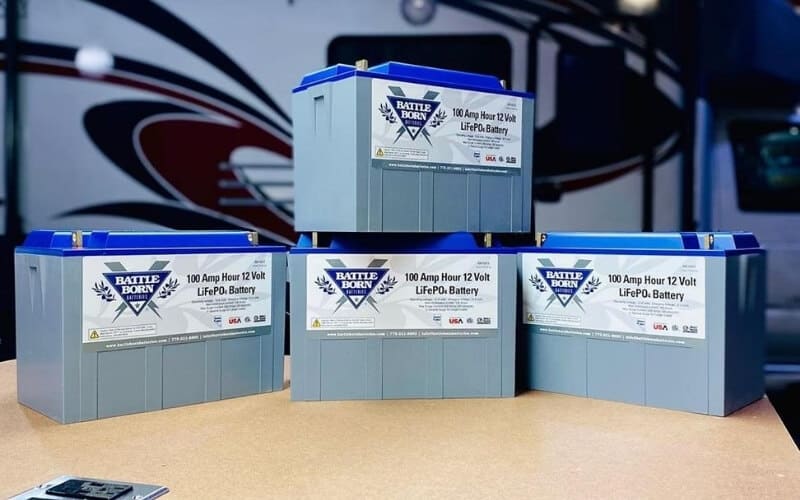
If you have an average 12 volt battery, you will be able to get around 100 amp hours of electrical storage. Under ideal conditions, this is sufficient to store up to 300 watts of solar panels.
If you had a pair of 12 volt batteries, or perhaps four 6 volt batteries, you would be able to store between 200 to 250 am hours, which should be enough to support up 600 watts of solar panels.
If you have a large Class A motorhome, your wattage and amp hour storage needs might be significantly higher.
In this scenario, lets say you have four robust 12 volt batteries, which would give you an impressive 400 to 600 amp hours of storage to support up to 1,200 watts from photovoltaic solar panels.
Tips For Conserving Energy
Right off the bat,there’s not a lot you can do to save power consumption on appliances like a microwave or coffee maker.
The best method for conserving power in your RV to reduce your solar demand is to start by looking at things you can easily and affordably power on.
Then you also need to ask yourself if it will pay off in the long-term.
For example, LED and compact fluorescent lightbulbs tend to use a lot less wattage than traditional incandescent bulbs.
They also tend to last much longer, which means you’re also saving money in replacement costs over the life of the RV.
On the other side of the spectrum, upgrading your RV’s existing water heater might cost a lot of money, only to save you 7 to 10% of wattage use compared to the older model. Here it would take years to see true savings in electricity use.
Once you comb through your light fixtures and appliances, you should be able to shave down your wattage needs by 10, to 15%.
You might want to also think about upgrading some of your entertainment devices. For example, older TV screens tend to use more watts per hour, than newer flatscreens.
So, you could upgrade the RV’s TV to a more energy-efficient flat screen, then sell your old TV or give it to your teenager to have a TV in their own bedroom.
There are also some basic lifestyle habits to consider adopting that will reduce the watts you need during the day.
This includes things like:
- Disconnect electronics and chargers when not in use to reduce the trickle draw of watts.
- Take shorter showers to reduce the energy demand of the hot water heater.
- Deploy the awning to shade the sidewall of your RV, which helps to reduce the draw on the air conditioner.
- Heat coffee and other warm beverages over a camp stove in a percolator.
- Turn off fans and other comfort devices when you’re not in the RV.
- Try to cook meals on the outdoor grill to keep from heating up the RV’s interior.
Conclusion
Your RV-ing lifestyle, personal habits, and the appliances you use onboard will certainly influence the wattage and amp-hour requirements of any RV solar system.
Making sure that you have enough 12-volt batteries to hold that storage is also just as essential as making sure you do your best to park your RV in the best possible location to maximize the performance of your photovoltaic solar panels.
If you have a large Class A motorhome, your solar demand in a day might be as high as 240 to maybe even 360 amp-hours of power.
Yet a smaller travel trailer, with modest appliances, energy-efficient LED lights, and mindful habits, might be able to live comfortably on 100 to 120 amp hours of green solar power.

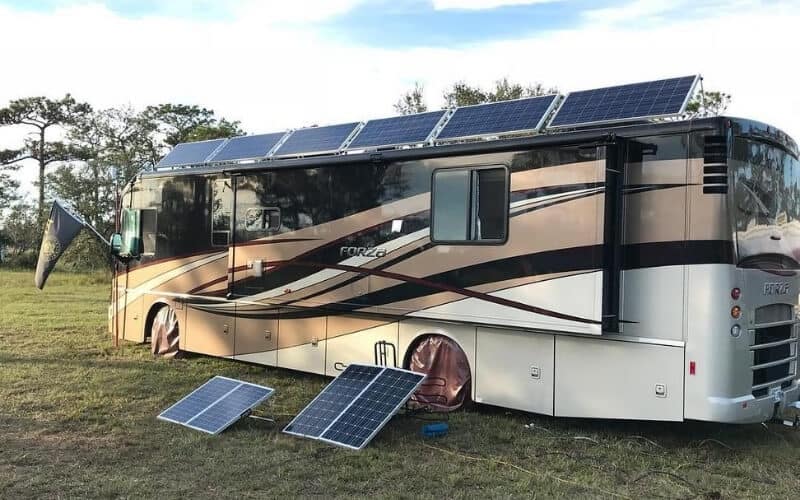

![Best Cars for Flat Towing Behind an RV in [currentyear]: Ultimate Guide for RVers 3 Best Cars To Tow Behind Rv 15 Best Types Of Cars For Towing 2020](https://www.rvingknowhow.com/wp-content/uploads/2019/11/Best-Cars-To-Tow-Behind-Rv-15-Best-Types-Of-Cars-For-Towing-2020-150x150.jpg)
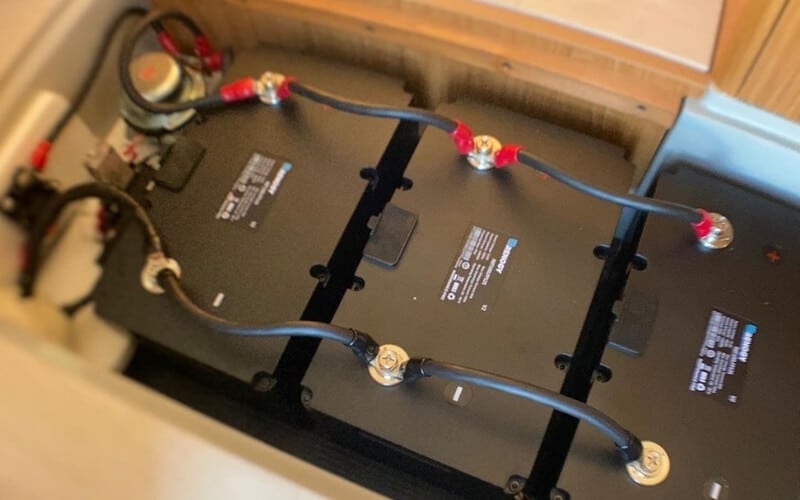
![6 Best Solar-Powered Generators for Portable Power Stations in [currentyear] 5 The Best Solar Generators For Camping](https://www.rvingknowhow.com/wp-content/uploads/2021/03/The-Best-Solar-Generators-For-Camping.jpg)
